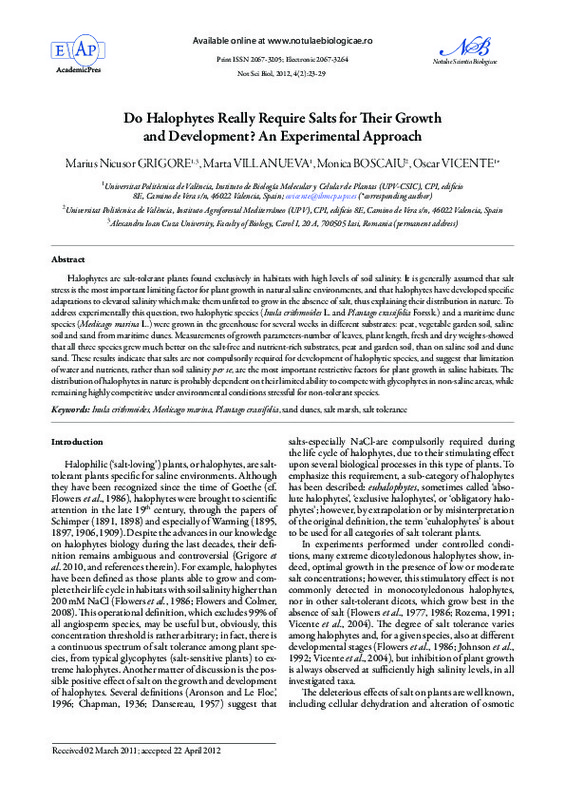JavaScript is disabled for your browser. Some features of this site may not work without it.
Buscar en RiuNet
Listar
Mi cuenta
Estadísticas
Ayuda RiuNet
Admin. UPV
Do Halophytes Really Require Salts for Their Growth and Development? An Experimental Approach
Mostrar el registro sencillo del ítem
Ficheros en el ítem
| dc.contributor.author | Grigore, Marius N.
|
es_ES |
| dc.contributor.author | Villanueva Lozano, Marta
|
es_ES |
| dc.contributor.author | Boscaiu Neagu, Mónica Tereza
|
es_ES |
| dc.contributor.author | Vicente Meana, Óscar
|
es_ES |
| dc.date.accessioned | 2017-03-20T11:57:07Z | |
| dc.date.available | 2017-03-20T11:57:07Z | |
| dc.date.issued | 2012 | |
| dc.identifier.issn | 2067-3205 | |
| dc.identifier.uri | http://hdl.handle.net/10251/78854 | |
| dc.description.abstract | [EN] Halophytes are salt-tolerant plants found exclusively in habitats with high levels of soil salinity. It is generally assumed that salt stress is the most important limiting factor for plant growth in natural saline environments, and that halophytes have developed specific adaptations to elevated salinity which make them unfitted to grow in the absence of salt, thus explaining their distribution in nature. To address experimentally this question, two halophytic species (Inula crithmoides L. and Plantago crassifolia Forssk.) and a maritime dune species (Medicago marina L.) were grown in the greenhouse for several weeks in different substrates: peat, vegetable garden soil, saline soil and sand from maritime dunes. Measurements of growth parameters-number of leaves, plant length, fresh and dry weights-showed that all three species grew much better on the salt-free and nutrient-rich substrates, peat and garden soil, than on saline soil and dune sand. These results indicate that salts are not compulsorily required for development of halophytic species, and suggest that limitation of water and nutrients, rather than soil salinity per se, are the most important restrictive factors for plant growth in saline habitats. The distribution of halophytes in nature is probably dependent on their limited ability to compete with glycophytes in non-saline areas, while remaining highly competitive under environmental conditions stressful for non-tolerant species. | es_ES |
| dc.description.sponsorship | This work was funded by the Spanish Ministry of Science and Innovation (project CGL2008-00438/BOS), with contribution from the European Regional Development Fund. M.-N.G. acknowledges the support provided by the Romanian POSDRU/89/1.5/S/49944 project ‘Developing the innovation capacity and improving the impact of research through post-doctoral programmes’, and by COST Action FA0901: ‘Putting Halophytes to work-From Genes to Ecosystems’ for his stay in Valencia in the frame of a Short Term Scientific Mission. | |
| dc.language | Inglés | es_ES |
| dc.publisher | Academic Press | es_ES |
| dc.relation.ispartof | Notulae Scientia Biologicae | es_ES |
| dc.rights | Reconocimiento (by) | es_ES |
| dc.subject | Inula crithmoides | es_ES |
| dc.subject | Medicago marina | es_ES |
| dc.subject | Plantago crassifolia | es_ES |
| dc.subject | Sand dunes | es_ES |
| dc.subject | Salt marsh | es_ES |
| dc.subject | Salt tolerance | es_ES |
| dc.subject.classification | BOTANICA | es_ES |
| dc.subject.classification | BIOQUIMICA Y BIOLOGIA MOLECULAR | es_ES |
| dc.title | Do Halophytes Really Require Salts for Their Growth and Development? An Experimental Approach | es_ES |
| dc.type | Artículo | es_ES |
| dc.identifier.doi | 10.15835/nsb427606 | es_ES |
| dc.relation.projectID | info:eu-repo/grantAgreement/COST//FA0901/EU/Putting Halophytes to Work - From Genes to Ecosystems/ | es_ES |
| dc.relation.projectID | info:eu-repo/grantAgreement/ESF//POSDRU%2F89%2F1.5%2F49944/ | es_ES |
| dc.relation.projectID | info:eu-repo/grantAgreement/MICINN//CGL2008-00438/ES/RESPUESTAS DE LAS PLANTAS AL ESTRES ABIOTICO: CORRELACION CON LAS CARACTERISTICAS EDAFICAS DE SUS HABITATS NATURALES/ | es_ES |
| dc.rights.accessRights | Abierto | es_ES |
| dc.contributor.affiliation | Universitat Politècnica de València. Instituto Universitario Mixto de Biología Molecular y Celular de Plantas - Institut Universitari Mixt de Biologia Molecular i Cel·lular de Plantes | es_ES |
| dc.contributor.affiliation | Universitat Politècnica de València. Instituto Agroforestal Mediterráneo - Institut Agroforestal Mediterrani | es_ES |
| dc.contributor.affiliation | Universitat Politècnica de València. Escuela Técnica Superior de Ingeniería Agronómica y del Medio Natural - Escola Tècnica Superior d'Enginyeria Agronòmica i del Medi Natural | es_ES |
| dc.description.bibliographicCitation | Grigore, MN.; Villanueva Lozano, M.; Boscaiu Neagu, MT.; Vicente Meana, Ó. (2012). Do Halophytes Really Require Salts for Their Growth and Development? An Experimental Approach. Notulae Scientia Biologicae. 4(2):23-29. https://doi.org/10.15835/nsb427606 | es_ES |
| dc.description.accrualMethod | S | es_ES |
| dc.relation.publisherversion | http://dx.doi.org/10.15835/nsb427606 | es_ES |
| dc.description.upvformatpinicio | 23 | es_ES |
| dc.description.upvformatpfin | 29 | es_ES |
| dc.type.version | info:eu-repo/semantics/publishedVersion | es_ES |
| dc.description.volume | 4 | es_ES |
| dc.description.issue | 2 | es_ES |
| dc.relation.senia | 230633 | es_ES |
| dc.identifier.eissn | 2067-3264 | |
| dc.contributor.funder | Ministerio de Ciencia e Innovación | |
| dc.contributor.funder | European Social Fund | es_ES |
| dc.contributor.funder | European Cooperation in Science and Technology | es_ES |
| dc.contributor.funder | European Commission |








